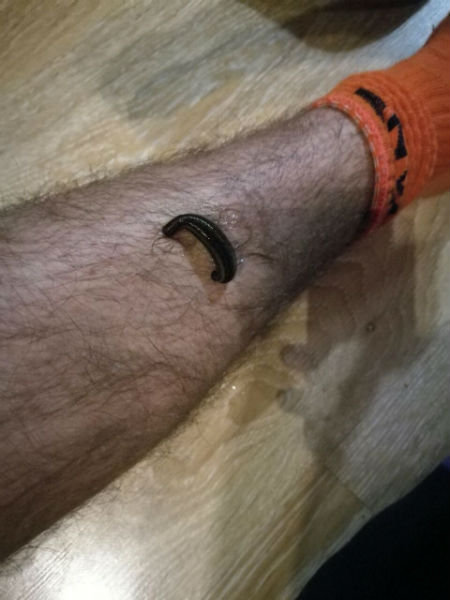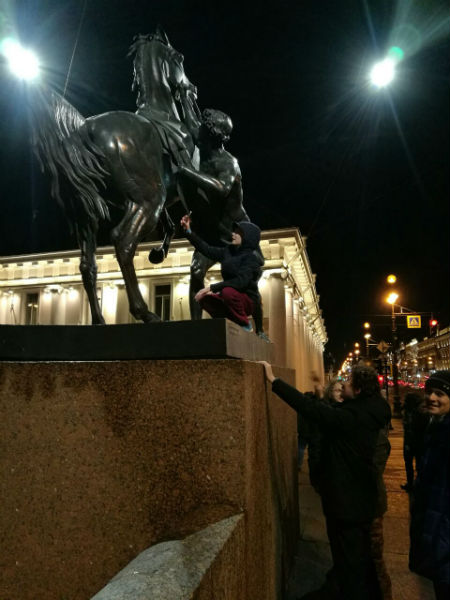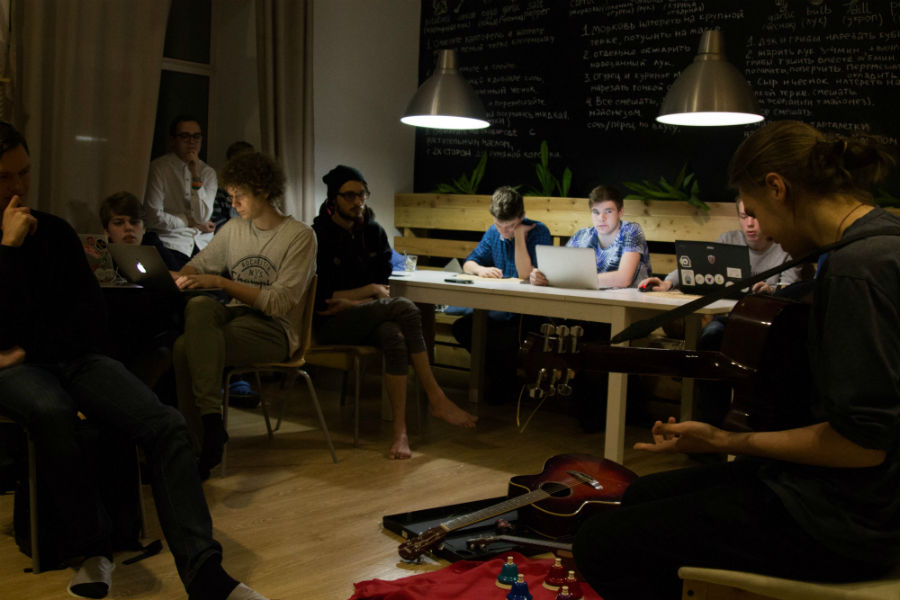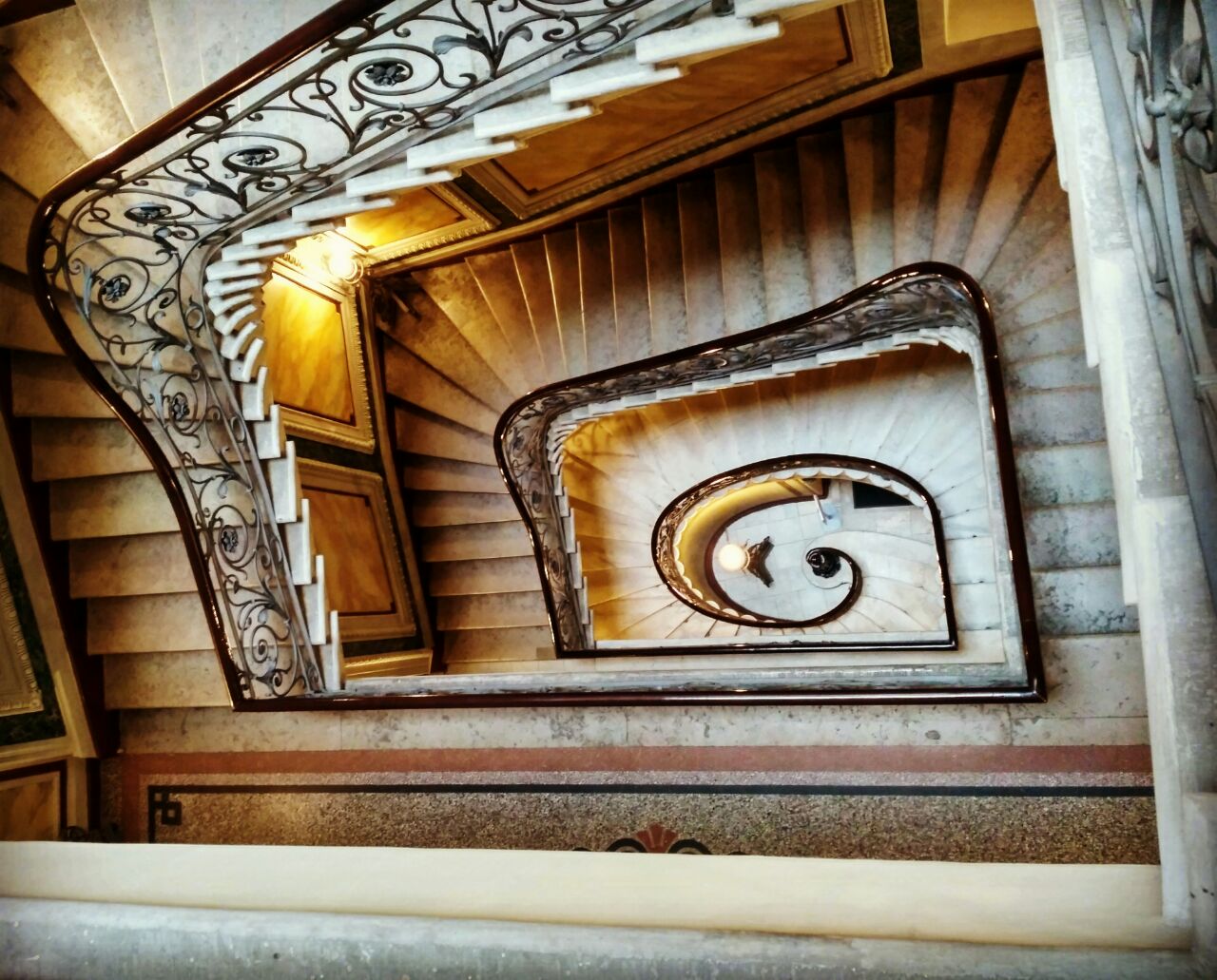Goto in ITMO: Botali week. Torn 2 accordions

Just recently, the regular GoTo school in St. Petersburg ended. Unlike last fall, this time, Peter pleased us with a large number of sunny and warm November days, there were two of them. On one of these days, combat units from young and not-so-programmers set out to get the code: kiss unfamiliar Petersburg girls, go to the Mariinka on an escalator, feed Oleg Infected with the blood of an innocent programmer and imprint Napoleon’s face between the legs of a horse.
On the other days, we did the same old-fashioned projects of no less fascinating projects on bioinformatics, machine learning, distributed systems, and chasing tea in the kitchen with conversations about beauty. ITMO report can be read here .
We do not undertake to judge that the reader is more interesting, about everything in order under the cut.
I will say right away, one of the most important events at GoTo Camp is dedication to programmers, or shortly “dedicate”. We will not reveal all the secrets, we just say that teams need to collect some code, complete tasks and get to the final point for dedication.
If at summer schools the organizers still have a place to roam: a field, a forest, puddles, then the city is not very good with the night forest. The proposals of St. Petersburg romantics to use the cemetery or the Neva in November were very attractive, but still decided that we were not ready for such a PR.
It was decided to confine ourselves to a quest around the city at night, on this beautiful day we met with Petersburgers, first kissed women and talked with passersby about GMOs and the blockchain. One of the teams decided to be more original - interviewed on an escalator - in the hope that it is more difficult for an intelligent person to get away from talking about the colonization of Mars:
- Do you think that we need to fly to Mars, or do we need to solve some more urgent problems?
- To whom? Us specifically? Or this all?
- Yes, yes, yes, to us and that’s all!
- I think they definitely need ... If they had flown away, I would definitely not resist. I specifically have nothing special to do there, I am not in a hurry, but since everything will soon come n ***, we should investigate this direction, purely just in case ...
But even if n *** comes, I will not get anywhere from here. So I don't need to go to Mars, so here ...
- Thank.
')
A pair of proofs



Yes, the topic of kisses did not reveal. One of the St. Petersburg cafes with its action “coffee for the unexpected kiss of a stranger” prompted the orgov to include an unforgettable adventure for many of the guys in the program. Remembering yourself in this wonderful age, you can imagine that storm of emotions and present this unique coffee with the taste of victory, the comments are unnecessary.
The team that had not managed to close the cafe had to meet the victim right on the street and kindly kiss at least her hand ...
An attentive reader will ask, what did the female participants do?
The proportion of women in our schools rarely exceeds the 10 percent mark, this time the catch is so rich - up to 6% barely reached. And yes, our beautiful ladies were the first to drink coffee in the corner.
We don’t list the total, since the hospitality of St. Petersburg was accompanied by: kind people allowed furious trinities to a closing pharmacy in an attempt to buy some pet, gave interviews and advice, changed books and things on the streets, stood the test of smiling and dancing, sang and played instead of Choi, for children's songs, we opened the closed doors and introduced us to the city.
What is interesting about this? Here is the task for you this evening, the simplest thing is to try several times to select a person in the subway and just smile at him, looking into his eyes for 5 minutes.
The evening went well, and even the simplest tasks proved to be good: even Petersburgers couldn’t find Napoleon’s face at the very same place on Anichkov’s horse’s bridge, and the moonlight added entourage to an unexpected coincidence - the monument to the invisible man with whom the team had to take a photo in the neighborhood of a mental hospital.
However, we will not reveal all the secrets, we hope that not the last time in St. Petersburg.
Everyone returned healthy and joyful, fed the pet and named Oleg Georgievich. The frustrated and frozen organizers slept especially well that night, in the morning they were waiting for this beautiful day - the day before the deadline and presentations.
And, by the way, some of the projects that were not too lazy to make descriptions for themselves in time.
Search in video
Initially, Stas Naumov set out to make a convenient program for glasses of mixed reality. Its essence can be described by two goals:
1) Reminders at sight. The user can add reminders and the next time when the glasses “see” the desired object, a notification will appear. For example, “withdraw money” will be displayed when a user sees an ATM.
2) Search for memories. At the request of the user to find a moment from the past, which answers the question asked. For example, to the question “Did I close the door?” The answer is a fragment of a video where the user leaves the apartment.
With the current computing power, these tasks are very difficult to solve in the “online” mode, so it was decided to reduce the task to a simpler one: search for the moment of the video by text description and tagging frames. By analogy with DSSM: using neural networks created a common space for images and texts.
In this space, the same in meaning pictures and texts are close as dots. This space was the result of the penultimate layer of the pre-trained VGG16. For texts, word2vec was used with subsequent processing by a one-dimensional convolutional network. By the final presentation of the projects in GoTo, we got a bot to search for the moment of the video using the text description.
DrugRNN
Now the process of developing new drugs is expensive and not always effective. For a long time, the whole farm would like to get a method that would allow to immediately generate the most suitable structures. In the project, Maxim Manainen trained RNN, which generates molecules for communication with given receptors under the condition of additional parameters (AlogP, AlogD, affinity with this receptor).
The process of learning the model is similar to learning the model for generating text - we feed it a sequence, and it learns to predict the next character under the condition of the previous ones. But here everything is not so simple. We need to generate molecules for communication with specific receptors, therefore, we need to train the model on the appropriate sample. However, the number of known reactive molecules is usually extremely small (about 1-5 thousand) and it is impossible to train RNN-ku in them due to the rapid overfit. To combat this, we had to resort to transfer learning — first we learn to generate abstract molecules, and then we train on the target sample. The final model generates 60-65% of valid smile-s before and after additional training.
The minima of the curves of implicit probabilities that the neuron puts smiles under the condition of affinity approach the real values of affinity, which indicates a good understanding of the features of molecules that react with the receptor. There were also attempts to validate the method using docking, but there were problems interpreting its results.
Exonum-http-get-auth
Rust-library for authentication of GET requests in Exonum and JS-snippet for generating a signature by an easy client.
The request is considered correct if its X-Auth HTTP header contains the signature of this key on the type, URL and time of sending, and if it was sent less than 30 seconds ago (for replay mitigation).
Difficulties in the development process of the project by Stepan Kuznetsov were connected, on the one hand, with the need to understand the relatively large and young (and therefore not always well-documented) framework, and on the other hand, with the nontrivial implementation of some patterns in Rust: abstract types, now the library only works with the nightly compiler.
Recommended system of educational courses
The project consists in recommending courses with various well-known resources, for example, Coursera, Stepik and so on. Recommendations are made on the basis of basic information about the user (education, proficiency in various programming languages, a stack of user technologies, etc.) and on the basis of a vacancy or analogues.
At the moment, the MVP version is ready, which is a web-based application in which the user fills in information about himself in several stages and then receives courses relevant to him. The basic version of the project implements the SVD decomposition algorithm based on the tags of courses, vacancies and key skills of the user, that is, the full text description is not taken into account, which negatively affects the quality of recommendations. Therefore, it was decided to begin to understand using a more advanced approach with DSSM, which will take into account the full text descriptions.
Speed Reading with EPOC +
A pair of students took on projects using the EPOC + neurointerface in the task of fast reading and determining interest in the text. One of the possible ways of speed reading is to show the text one word at a time, and the words switch at high speed. This method is especially convenient for reading on small screens, for example, on mobile phones. Problems of simple applications arise when the reader is thinking or distracted and can skip part of the text and can no longer easily go back. The guys tried to catch the moments when the user loses the thread of the story and slow down the text on them. For the task with attention - we received the text with markup on interesting and boring or not informative places in the text, or simply the markup of our concentration in the process of reading.
In the course of the project, they wrote and compared the work of the autoregressive neural network recognizing the signals from the neural interface, RNN, smoothly began to move towards the addition of reinforcement learning for scaling to people with different patterns.
Recognition of notes in piano works
Recognition of notes in piano works
A neural network that allows you to recognize notes in recorded piano works.
Alena Karnaukhova implemented a model that translates sound files with piano recording into their musical notation.
The main network that recognizes notes is the convolutional neural network (“generator”). She was trained to recognize chords on clean (no noise) data. But if you submit such a network to the input of real data, it will not cope with the task. Therefore, in parallel with the recognition of notes, the convolutional network learned to distinguish real data from pure ones. The second neural network, the discriminator, helped her in this. She took the processed data from the penultimate fully-connected layer of the convolutional network and tried, on the contrary, to learn how to accurately distinguish the noisy data from the pure ones. Thus, forcing the convolutional network and discriminator to “compete,” the model learned to recognize notes in real piano works with an accuracy of 70%.
Assessment of gene expression correlation: comparison of robust methods
Since noises and outliers are often present in biological data, it is important to use correct correlation estimation methods. But many of them are used undeservedly little, although according to theoretical data, they are more resistant to certain noises.
The basis of the project of Maria Sivtsova was the article “Sparse Estimation of High-dimensional Correlation Matrices”, which compared various methods for assessing the correlation, and the problem of calculating the correlation in biological data - the gene expression matrix. A comparison was made on the generated biological data using the Splatter library and several types of noise on two different groups of cells. As a result, on a small sample the same methods showed themselves differently, but some of them were very unstable to specific types of noise. In general, the results obtained corresponded to the theoretical results from
articles. In the future, it is also planned to use other methods and consider them in new examples.
The rest happily left us only the code and the presentations on the projects, completed the courses and acquired a lot of knowledge on future projects.
Initially, Stas Naumov set out to make a convenient program for glasses of mixed reality. Its essence can be described by two goals:
1) Reminders at sight. The user can add reminders and the next time when the glasses “see” the desired object, a notification will appear. For example, “withdraw money” will be displayed when a user sees an ATM.
2) Search for memories. At the request of the user to find a moment from the past, which answers the question asked. For example, to the question “Did I close the door?” The answer is a fragment of a video where the user leaves the apartment.
With the current computing power, these tasks are very difficult to solve in the “online” mode, so it was decided to reduce the task to a simpler one: search for the moment of the video by text description and tagging frames. By analogy with DSSM: using neural networks created a common space for images and texts.
In this space, the same in meaning pictures and texts are close as dots. This space was the result of the penultimate layer of the pre-trained VGG16. For texts, word2vec was used with subsequent processing by a one-dimensional convolutional network. By the final presentation of the projects in GoTo, we got a bot to search for the moment of the video using the text description.
DrugRNN
Now the process of developing new drugs is expensive and not always effective. For a long time, the whole farm would like to get a method that would allow to immediately generate the most suitable structures. In the project, Maxim Manainen trained RNN, which generates molecules for communication with given receptors under the condition of additional parameters (AlogP, AlogD, affinity with this receptor).
The process of learning the model is similar to learning the model for generating text - we feed it a sequence, and it learns to predict the next character under the condition of the previous ones. But here everything is not so simple. We need to generate molecules for communication with specific receptors, therefore, we need to train the model on the appropriate sample. However, the number of known reactive molecules is usually extremely small (about 1-5 thousand) and it is impossible to train RNN-ku in them due to the rapid overfit. To combat this, we had to resort to transfer learning — first we learn to generate abstract molecules, and then we train on the target sample. The final model generates 60-65% of valid smile-s before and after additional training.
The minima of the curves of implicit probabilities that the neuron puts smiles under the condition of affinity approach the real values of affinity, which indicates a good understanding of the features of molecules that react with the receptor. There were also attempts to validate the method using docking, but there were problems interpreting its results.
Exonum-http-get-auth
Rust-library for authentication of GET requests in Exonum and JS-snippet for generating a signature by an easy client.
The request is considered correct if its X-Auth HTTP header contains the signature of this key on the type, URL and time of sending, and if it was sent less than 30 seconds ago (for replay mitigation).
Difficulties in the development process of the project by Stepan Kuznetsov were connected, on the one hand, with the need to understand the relatively large and young (and therefore not always well-documented) framework, and on the other hand, with the nontrivial implementation of some patterns in Rust: abstract types, now the library only works with the nightly compiler.
Recommended system of educational courses
The project consists in recommending courses with various well-known resources, for example, Coursera, Stepik and so on. Recommendations are made on the basis of basic information about the user (education, proficiency in various programming languages, a stack of user technologies, etc.) and on the basis of a vacancy or analogues.
At the moment, the MVP version is ready, which is a web-based application in which the user fills in information about himself in several stages and then receives courses relevant to him. The basic version of the project implements the SVD decomposition algorithm based on the tags of courses, vacancies and key skills of the user, that is, the full text description is not taken into account, which negatively affects the quality of recommendations. Therefore, it was decided to begin to understand using a more advanced approach with DSSM, which will take into account the full text descriptions.
Speed Reading with EPOC +
A pair of students took on projects using the EPOC + neurointerface in the task of fast reading and determining interest in the text. One of the possible ways of speed reading is to show the text one word at a time, and the words switch at high speed. This method is especially convenient for reading on small screens, for example, on mobile phones. Problems of simple applications arise when the reader is thinking or distracted and can skip part of the text and can no longer easily go back. The guys tried to catch the moments when the user loses the thread of the story and slow down the text on them. For the task with attention - we received the text with markup on interesting and boring or not informative places in the text, or simply the markup of our concentration in the process of reading.
In the course of the project, they wrote and compared the work of the autoregressive neural network recognizing the signals from the neural interface, RNN, smoothly began to move towards the addition of reinforcement learning for scaling to people with different patterns.
Recognition of notes in piano works
Recognition of notes in piano works
A neural network that allows you to recognize notes in recorded piano works.
Alena Karnaukhova implemented a model that translates sound files with piano recording into their musical notation.
The main network that recognizes notes is the convolutional neural network (“generator”). She was trained to recognize chords on clean (no noise) data. But if you submit such a network to the input of real data, it will not cope with the task. Therefore, in parallel with the recognition of notes, the convolutional network learned to distinguish real data from pure ones. The second neural network, the discriminator, helped her in this. She took the processed data from the penultimate fully-connected layer of the convolutional network and tried, on the contrary, to learn how to accurately distinguish the noisy data from the pure ones. Thus, forcing the convolutional network and discriminator to “compete,” the model learned to recognize notes in real piano works with an accuracy of 70%.
Assessment of gene expression correlation: comparison of robust methods
Since noises and outliers are often present in biological data, it is important to use correct correlation estimation methods. But many of them are used undeservedly little, although according to theoretical data, they are more resistant to certain noises.
The basis of the project of Maria Sivtsova was the article “Sparse Estimation of High-dimensional Correlation Matrices”, which compared various methods for assessing the correlation, and the problem of calculating the correlation in biological data - the gene expression matrix. A comparison was made on the generated biological data using the Splatter library and several types of noise on two different groups of cells. As a result, on a small sample the same methods showed themselves differently, but some of them were very unstable to specific types of noise. In general, the results obtained corresponded to the theoretical results from
articles. In the future, it is also planned to use other methods and consider them in new examples.
The rest happily left us only the code and the presentations on the projects, completed the courses and acquired a lot of knowledge on future projects.
Oh yes, where 2 button accordions, you ask.
Proudly capturing one of the fully hostels with a large kitchen, we decided to recall the stories of the apartment fans and literary clubs, and make our own Green Lantern.
We invited archeologists and mathematicians in the evenings and just had interesting conversations with a tea bag from a bag. One evening musicians came to visit us, alive and real!
We have not yet reached the cradle of ordering programmers, although the Bashkir tales at night read what to hide, you will not find such trash, they could not help but share. Were these friends of our "Kultorg" Nastya Ivanova-Moskovskaya (in narrow circles Baba Nastya) - the group "Kill the barber". It is worth noting that it is extremely useful to be friends with non-programmer schools, Nastya leads the workshops at the Summer School (the one that was previously called LS RR) and introduces us to a lot of interesting people from another world. The school, by the way, is cool, we are jealous of white envy - they can go to the woods with tents, but we can only dream of a good internet in nature. The guys are very enthusiastic, besides guitars, they played the bells, the saw and the metallophone. It was very touching and soulful, somewhere near the end, even the harshest hearts of those programming in the corner melted away and pushed the laptops away, putting neurons to learn. After that, all musical instruments fell into the hands of programmers, which is as usual - neither in a fairy tale to say nor to describe with a pen.

And the school itself was rather soulful, although very quickly, it was short. But we all had time, met and spent a lot of useful hours with ITMO, BIOCAD, BitFury, WorldQuant, IDealMachine - talked with Fyodor Tsarev about what to do after you became the world champion in programming, about why go to the biotech machine manager , about accelerators and investments, dealt with HYIP around the blockchain along with Exonum.
She was sheltered by an extremely entertaining and beautiful building on Vaska, where the first elevator appeared and now it houses the Technopark of ITMO University. This institution appeared at the beginning of the 20th century, there was Tsarevich Nikolai's vocational school for watch and optical craftsmen. Every morning we were pleased with a beautiful staircase: half spiral, half rectangular.

In winter, we explore the Vnesheconombank House and MISiS, there they will open the Blockchain Competency Center the other day, get acquainted with Soviet constructivism in architecture and not only.
By the way, this time on the New Year holidays we are planning a parallel school in Berlin - a kind of workshop together with GNUnet, secushare, Matrix, CCC, C-base and other communities. It seems to us that interaction with foreign communities and open-source projects is very important, we hope to move in this direction, join .
Source: https://habr.com/ru/post/342996/
All Articles